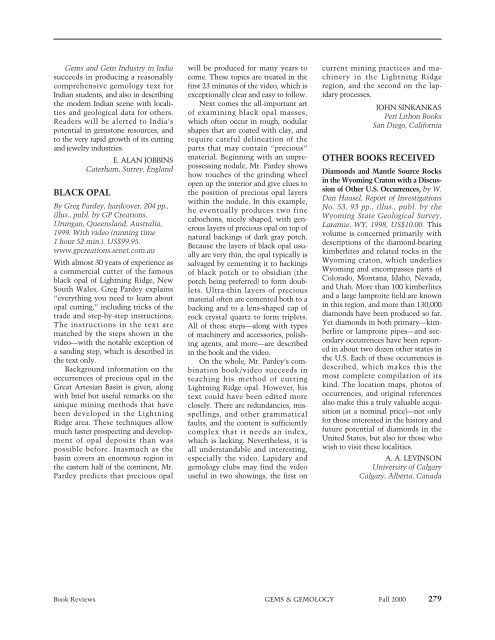Fall 2000 Gems & Gemology - Gemfrance
Fall 2000 Gems & Gemology - Gemfrance
Fall 2000 Gems & Gemology - Gemfrance
Create successful ePaper yourself
Turn your PDF publications into a flip-book with our unique Google optimized e-Paper software.
<strong>Gems</strong> and Gem Industry in India<br />
succeeds in producing a reasonably<br />
comprehensive gemology text for<br />
Indian students, and also in describing<br />
the modern Indian scene with localities<br />
and geological data for others.<br />
Readers will be alerted to India’s<br />
potential in gemstone resources, and<br />
to the very rapid growth of its cutting<br />
and jewelry industries.<br />
E. ALAN JOBBINS<br />
Caterham, Surrey, England<br />
BLACK OPAL<br />
By Greg Pardey, hardcover, 204 pp.,<br />
illus., publ. by GP Creations,<br />
Urungan, Queensland, Australia,<br />
1999. With video (running time<br />
1 hour 52 min.). US$99.95.<br />
www.gpcreations.senet.com.au<br />
With almost 30 years of experience as<br />
a commercial cutter of the famous<br />
black opal of Lightning Ridge, New<br />
South Wales, Greg Pardey explains<br />
“everything you need to learn about<br />
opal cutting,” including tricks of the<br />
trade and step-by-step instructions.<br />
The instructions in the text are<br />
matched by the steps shown in the<br />
video—with the notable exception of<br />
a sanding step, which is described in<br />
the text only.<br />
Background information on the<br />
occurrences of precious opal in the<br />
Great Artesian Basin is given, along<br />
with brief but useful remarks on the<br />
unique mining methods that have<br />
been developed in the Lightning<br />
Ridge area. These techniques allow<br />
much faster prospecting and development<br />
of opal deposits than was<br />
possible before. Inasmuch as the<br />
basin covers an enormous region in<br />
the eastern half of the continent, Mr.<br />
Pardey predicts that precious opal<br />
will be produced for many years to<br />
come. These topics are treated in the<br />
first 23 minutes of the video, which is<br />
exceptionally clear and easy to follow.<br />
Next comes the all-important art<br />
of examining black opal masses,<br />
which often occur in rough, nodular<br />
shapes that are coated with clay, and<br />
require careful delineation of the<br />
parts that may contain “precious”<br />
material. Beginning with an unprepossessing<br />
nodule, Mr. Pardey shows<br />
how touches of the grinding wheel<br />
open up the interior and give clues to<br />
the position of precious opal layers<br />
within the nodule. In this example,<br />
he eventually produces two fine<br />
cabochons, nicely shaped, with generous<br />
layers of precious opal on top of<br />
natural backings of dark gray potch.<br />
Because the layers of black opal usually<br />
are very thin, the opal typically is<br />
salvaged by cementing it to backings<br />
of black potch or to obsidian (the<br />
potch being preferred) to form doublets.<br />
Ultra-thin layers of precious<br />
material often are cemented both to a<br />
backing and to a lens-shaped cap of<br />
rock crystal quartz to form triplets.<br />
All of these steps—along with types<br />
of machinery and accessories, polishing<br />
agents, and more—are described<br />
in the book and the video.<br />
On the whole, Mr. Pardey’s combination<br />
book/video succeeds in<br />
teaching his method of cutting<br />
Lightning Ridge opal. However, his<br />
text could have been edited more<br />
closely. There are redundancies, misspellings,<br />
and other grammatical<br />
faults, and the content is sufficiently<br />
complex that it needs an index,<br />
which is lacking. Nevertheless, it is<br />
all understandable and interesting,<br />
especially the video. Lapidary and<br />
gemology clubs may find the video<br />
useful in two showings, the first on<br />
current mining practices and machinery<br />
in the Lightning Ridge<br />
region, and the second on the lapidary<br />
processes.<br />
JOHN SINKANKAS<br />
Peri Lithon Books<br />
San Diego, California<br />
OTHER BOOKS RECEIVED<br />
Diamonds and Mantle Source Rocks<br />
in the Wyoming Craton with a Discussion<br />
of Other U.S. Occurrences, by W.<br />
Dan Hausel, Report of Investigations<br />
No. 53, 93 pp., illus., publ. by the<br />
Wyoming State Geological Survey,<br />
Laramie, WY, 1998, US$10.00. This<br />
volume is concerned primarily with<br />
descriptions of the diamond-bearing<br />
kimberlites and related rocks in the<br />
Wyoming craton, which underlies<br />
Wyoming and encompasses parts of<br />
Colorado, Montana, Idaho, Nevada,<br />
and Utah. More than 100 kimberlites<br />
and a large lamproite field are known<br />
in this region, and more than 130,000<br />
diamonds have been produced so far.<br />
Yet diamonds in both primary—kimberlite<br />
or lamproite pipes—and secondary<br />
occurrences have been reported<br />
in about two dozen other states in<br />
the U.S. Each of these occurrences is<br />
described, which makes this the<br />
most complete compilation of its<br />
kind. The location maps, photos of<br />
occurrences, and original references<br />
also make this a truly valuable acquisition<br />
(at a nominal price)—not only<br />
for those interested in the history and<br />
future potential of diamonds in the<br />
United States, but also for those who<br />
wish to visit these localities.<br />
A. A. LEVINSON<br />
University of Calgary<br />
Calgary, Alberta, Canada<br />
Book Reviews GEMS & GEMOLOGY <strong>Fall</strong> <strong>2000</strong> 279


